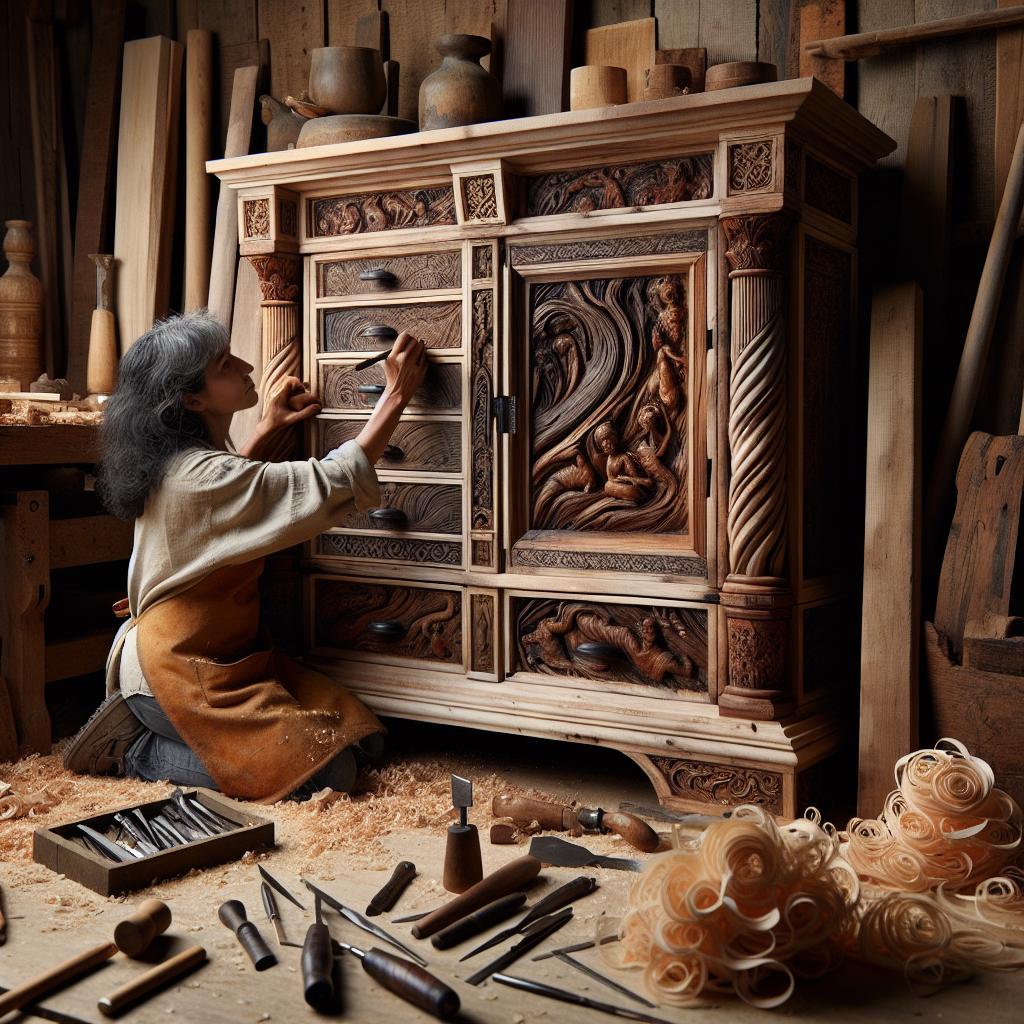In a world increasingly captivated by sustainability, the art of cabinetmaking with reclaimed wood stands as a testament to the beauty of renewal and resourcefulness. Each piece crafted from this aged timber tells a story of the past, weaving together history and craftsmanship into functional works of art. From weathered barn beams to remnants of old furniture, reclaimed wood carries with it the character of its former life, infusing unique textures and colors into new designs. As artisans embrace this eco-friendly approach, they not only honor the environment but also celebrate the creativity that emerges when tradition meets innovation. In this exploration of cabinetmaking with reclaimed wood, we delve into the techniques, benefits, and inspirational projects that illuminate this harmonious marriage of past and present.
Exploring the Charms of Reclaimed Wood in Cabinetmaking
Cabinetmaking with reclaimed wood introduces a world rich in history and character. Every piece carries the marks of time, often revealing unique patterns, colors, and textures that create visually stunning furniture. Crafting cabinets from this sustainable material allows artisans to tell a story with each creation, revealing the journeys of the trees that have stood for decades, sometimes centuries. The beauty of reclaimed wood lies not just in its aesthetic appeal but also in its profound environmental benefits, which include:
- Eco-friendliness: Utilizing reclaimed wood reduces the demand for new lumber, thereby conserving forests.
- Durability: Many reclaimed woods, such as barn wood or old timbers, have aged naturally, resulting in a strong, resilient material.
- Character: The imperfections and natural variations in reclaimed wood yield one-of-a-kind pieces.
Incorporating reclaimed wood into cabinet design is a testament to creativity and sustainability. Craftsmen often face challenges such as varying dimensions and potential inconsistencies, but these can be transformed into opportunities for innovation. By implementing clever joinery techniques and finishing methods that highlight the wood’s original features, artisans create cabinetry that is as functional as it is distinctive. Below is a simple comparison table that highlights some preferred types of reclaimed wood in cabinetmaking:
| Type of Reclaimed Wood | Common Source | Unique Feature |
|---|---|---|
| Barn Wood | Old barns and agricultural buildings | Weathered patina |
| Teak | Old ships and docks | Natural oils for moisture resistance |
| Heart Pine | Historic buildings | Rich color and dense grain |
Techniques for Selecting and Preparing Reclaimed Materials
Selecting reclaimed wood requires a discerning eye and an appreciation for the character that each piece offers. Start by examining the wood for its condition; look for soundness, checking for cracks or signs of decay. Prioritize pieces with unique grain patterns and rich colors, as these will enhance the final cabinet’s aesthetic. Consider the wood’s origin—historical buildings, old barns, or wine barrels often yield lumber with interesting stories. Document any provenance, as it can add value and a touch of authenticity to your project.
Once you’ve curated your materials, preparation is key to ensuring that your reclaimed wood is ready for cabinetmaking. Begin with a thorough cleaning to remove any dirt, grease, or old finishes that may affect adhesion or appearance. Utilize a combination of scrapers and sanders, taking care not to strip away the wood’s character. After cleaning, apply a stabilizing treatment to enhance structural integrity, especially for pieces with prior wear. cut your materials to size and plan your joinery methods, keeping in mind the grain direction to maximize strength and beauty.

Design Ideas to Enhance the Beauty of Reclaimed Wood Cabinets
Incorporating reclaimed wood cabinets into your space not only serves as a sustainable choice but also brings a rustic charm that can be amplified through thoughtful design elements. To enhance the inherent beauty of reclaimed wood, consider contrasting hardware that highlights the unique textures and tones of the wood. For instance, matte black or brushed bronze handles and knobs can provide a stunning visual contrast that draws the eye. Pair these with a light-colored backsplash or countertop to create balance and allow the rich hues of the wood to take center stage.
Another dynamic approach is to juxtapose reclaimed wood cabinets with modern design features. This can be achieved by integrating sleek, minimalist shelving or using glass-fronted cabinet doors that showcase the wood’s character while softening the overall look. Adding LED strip lighting beneath the cabinets can create a warm ambiance, accentuating the wood grain and inviting charm of the space. Remember, the goal is to celebrate the story behind each piece of wood; therefore, displaying its raw edges and natural imperfections can create a unique focal point that evokes the spirit of craftsmanship.

Sustainability Practices in Reclaimed Wood Cabinetmaking
In the world of cabinetmaking, reclaimed wood stands out as a sustainable choice, significantly reducing the demand for new timber. By salvaging wood from old buildings, furniture, or other structures, craftsmen are not only preserving the unique beauty of the material but also minimizing environmental impact. This practice helps to reduce deforestation, as fewer trees are felled to accommodate growing consumer needs. Furthermore, the use of reclaimed wood often leads to the conservation of historical materials, adding character and backstory to each piece crafted.
Implementing sustainable practices in this craft extends beyond the choice of materials. Many cabinetmakers prioritize eco-friendly finishes and adhesives that are free from harsh chemicals. They may also incorporate energy-efficient manufacturing processes, striving to minimize waste through careful planning and design. Additionally, some artisans embrace a circular economy by encouraging customers to return old furniture for upcycling, fostering a sense of responsibility and awareness around consumption. Key sustainability practices include:
- Source sustainable materials: Prioritize reclaimed over new wood.
- Eco-friendly finishes: Use low-VOC or water-based products.
- Waste reduction: Optimize cutting plans to use materials efficiently.
- Community engagement: Promote the benefits of reclaimed materials.
Q&A
Q&A: Exploring Cabinetmaking with Reclaimed Wood
Q: What is cabinetmaking with reclaimed wood?
A: Cabinetmaking with reclaimed wood involves the craft of creating furniture and cabinetry using timber sourced from old buildings, pallets, and other discarded wood items. This practice emphasizes sustainability by repurposing materials that might otherwise end up in landfills, showcasing unique character and history in each piece.
Q: Why is reclaimed wood becoming popular in cabinetmaking?
A: Reclaimed wood is gaining popularity due to its environmental benefits, unique aesthetics, and superior durability. Many craftsmen and consumers appreciate the charm of aged wood, which often has rich textures, distinctive colors, and beautiful imperfections that tell a story. Moreover, using reclaimed materials aligns with eco-conscious values, appealing to those who wish to minimize their ecological footprint.
Q: What types of reclaimed wood are commonly used in cabinetmaking?
A: Various types of reclaimed wood are used in cabinetmaking, including barn wood, old growth timber, pallets, and deconstructed furniture. Hardwood species like oak, walnut, and maple are particularly prized for their strength and beauty. Each type contributes different qualities, such as grain patterns and coloration, allowing for creative expression in designs.
Q: Are there challenges associated with working with reclaimed wood?
A: Yes, while reclaimed wood offers unique benefits, it also presents challenges. It’s often irregular and may contain nails or other hardware that must be removed. The drying and treatment process can be lengthy, as reclaimed wood may have absorbed moisture or been subject to pests. Additionally, finding consistent quality and sourcing materials can be a bit trickier than with new timber.
Q: How does the finishing process differ when using reclaimed wood?
A: The finishing process for reclaimed wood can vary significantly due to its unique characteristics. Craftsmen often opt for finishes that enhance the wood’s natural beauty, such as oils or matte varnishes, which allow the grain and imperfections to shine. However, it’s essential to stimulate proper preparation, as ensuring the surface is clean and appropriately sanded will affect how well the finish adheres and appears.
Q: Can reclaimed wood be used for all types of cabinetry?
A: Absolutely! Reclaimed wood can be used for a wide range of cabinetry, including kitchen cabinets, bathroom vanities, and even custom shelving. Its versatility and unique aesthetics make it suitable for both traditional and modern designs. However, the structural integrity of the wood is crucial, so it’s essential to evaluate each piece before incorporating it into functional cabinets.
Q: What are some design considerations when using reclaimed wood for cabinets?
A: When designing with reclaimed wood, consider the overall style of your space and how the wood’s characteristics complement it. Pay attention to grain direction, color variations, and the presence of knots or other features, as these elements contribute to the visual interest of your cabinets. Additionally, think about hardware and finish options that align with the rustic or vintage charm that reclaimed wood often brings.
Q: Is it possible to find reclaimed wood of high quality?
A: Yes, it is indeed possible to find quality reclaimed wood, but it requires careful sourcing. Reputable suppliers or specialty reclaimed wood retailers often curate high-grade materials, ensuring they meet industry standards. Crafting with reputable sources not only guarantees better quality but also supports sustainable practices and responsible forestry initiatives.
Q: How can consumers ensure they are making a sustainable choice when purchasing reclaimed cabinetry?
A: To ensure sustainability, consumers can research suppliers’ sourcing practices, verifying that the reclaimed wood is ethically obtained and processed. Choosing local artisans or companies that prioritize sustainability can further enhance the eco-friendly aspect. Additionally, asking about materials and finishes used—opting for non-toxic and environmentally friendly options—helps to mitigate the environmental impact of cabinetry projects.
Q: What can one expect from a finished cabinet made with reclaimed wood?
A: A finished cabinet made with reclaimed wood typically radiates warmth and character, showcasing the unique marks of its past while fitting seamlessly into contemporary or rustic spaces. Each piece often tells a story, making it an attractive focal point in any room. Beyond aesthetics, these cabinets are durable and built to last, combining beauty with functionality for generations to come.
Conclusion: Cabinetmaking with reclaimed wood offers an intersection of utility, artistry, and sustainability, illuminating both the past and present through each crafted piece. By embracing this practice, craftsmen not only create beautiful furniture but also contribute to a more sustainable future.
Future Outlook
cabinetmaking with reclaimed wood is more than just a craftsmanship; it’s a celebration of history, sustainability, and ingenuity. Each piece crafted from salvaged materials tells a unique story, imbuing spaces with character and warmth while minimizing our impact on the environment. By choosing reclaimed wood, artisans and homeowners alike contribute to a circular economy, breathing new life into materials that might otherwise be forgotten. As you embark on your own cabinetmaking journey or consider the beauty of reclaimed pieces for your home, remember that each selection is a step toward preserving our planet’s rich heritage while creating bespoke elements that resonate with purpose and elegance. Embrace the charm of reclaimed wood and let your creations echo the whispers of the past, beautifully reimagined for the present and future.

